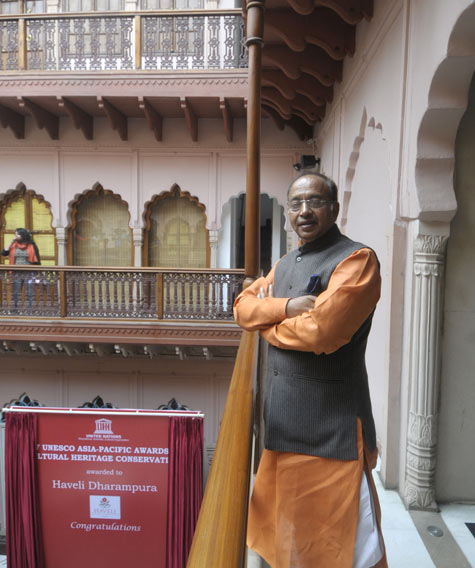The street is only seven feet wide; no car can venture in. You have to leave your vehicle at the Jama Masjid police chowky and walk the last few hundred metres. Deep in the bowels of congested Chandni Chowk, amidst the ancient buildings through which light doesn't penetrate, is Haveli Dharampur, amazingly spacious, naturally ventilated and beautifully lit up by the sun whose rays spread to every room that open onto the central courtyard.
 Union minister Vijay Goel at Havel Dharampura
Union minister Vijay Goel at Havel Dharampura
Haveli Dharampura is Union minister of state for parliamentary affairs Vijay Goel's pride and passion. “Heritage is my first love, politics second,'' says the BJP leader beaming with pride as he announces that the haveli has been awarded the prestigious UNESCO 2017 Asia Pacific award for cultural heritage. It is not a mean feat; this haveli is the only building in the national capital (which is teaming with heritage structures) to win the tag.
Chandni Chowk is believed to have been built during the reign of Mughal Emperor Shah Jahan by his daughter. Over the years, however, the square which is said to have been a beauty to behold in the moonlight (from where it gets its name) has turned into the urban nightmare that old sections of India cities are: the narrow lanes crowded with handcarts and honking bikes, electric cables hanging overhead in a dangerous tangle, a posse of people living and trading cheek by jowl; each unit sublets several times till the original architecture is a blur, and the splendour long forgotten in grimy walls or worse, mindless modern rebuilding.
There are around 450 big havelis in the Chandni Chowk area, say experts from the School of Planning and Hetirage. Only three or four of them have been restored. Haveli Dharampura is certainly a jewel from the past that has been polished and presented in renewed splendour.
The citation says, “The conservation of Haveli Dharampura rescued an extraordinary 19th century residence in old Delhi from years of unsuitable interventions and adapted it for contemporary use as a luxe boutique hotel. The haveli ’s original spatial configuration was re -established and ornate architectural elements were carefully restored, returning the building to its former splendour. ''
Goel purchased the late Mughal era haveli from its owner, a Jain family (who had bought it from Muslim owners), and began restoration in 2010. It took him six years, and each process was a learning experience. He has used traditional practices while sourcing material and expertise was a challenge. “I've used Lahori bricks, like the ones originally used in this 200-year-old structure. You don't get these narrow bricks any more, and when you do, they cost Rs 7 a piece.'' Instead of cement, traditional mortar made of jaggery, husk and several other natural ingredients were mixed manually. Though he recruited restoration architects, there were times when only the local jugaad helped. A local worker, who does unauthorised repairs in the neighbourhood turned out to be the go to person when all else failed.
While the restoration itself was a pain-staking process, at least it was a happy, exhilarating one. The process of getting permits and clearances from various government departments is a nightmare Goel cannot forget. “Restoration work should be encouraged, not blocked with red tape,'' he says.
In the central courtyard of his hotel today is a tinkling fountain. What visitors do not realise is that beneath them is the water reservoir, because it was too heavy to be put on the roof. “We discovered so many interesting nooks when we cleared out the haveli. Several tijoris (lockers), none with money, though. One is on display for viewers.'' Goel recalls that when he bought the building, it was in the municipal corporation's list of dangerous buildings; so dilapidated was it. Goel has kept a picture, in the central courtyard, of the building before restoration.
The Welcome group-run hotel today has a good international clientele, but the restaurants are open for all. Weekends get you to enjoy a good kathak performance along with the delectable cuisine of Old Delhi—palak ki chaat, biryani, beetroot kheer and that delectable confection of cream and sugar— Daulat ki chaat, where the cream is whipped into a little white cloud.





